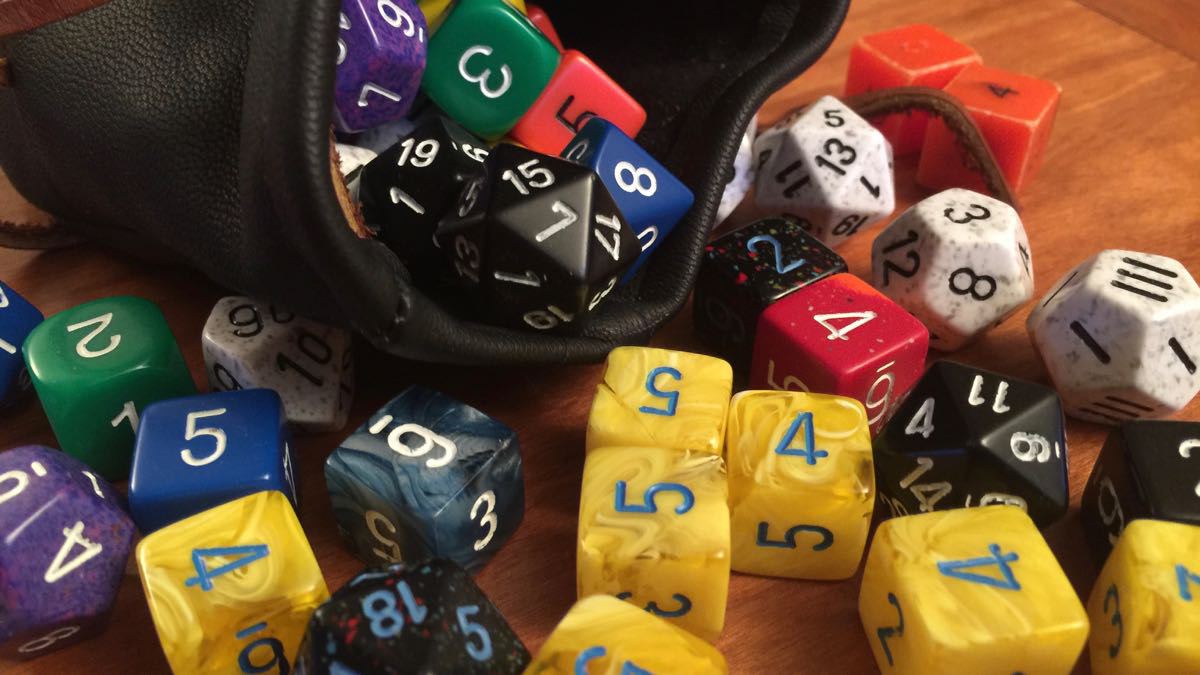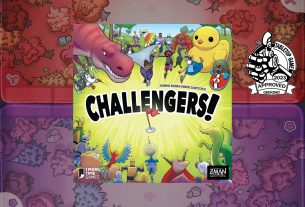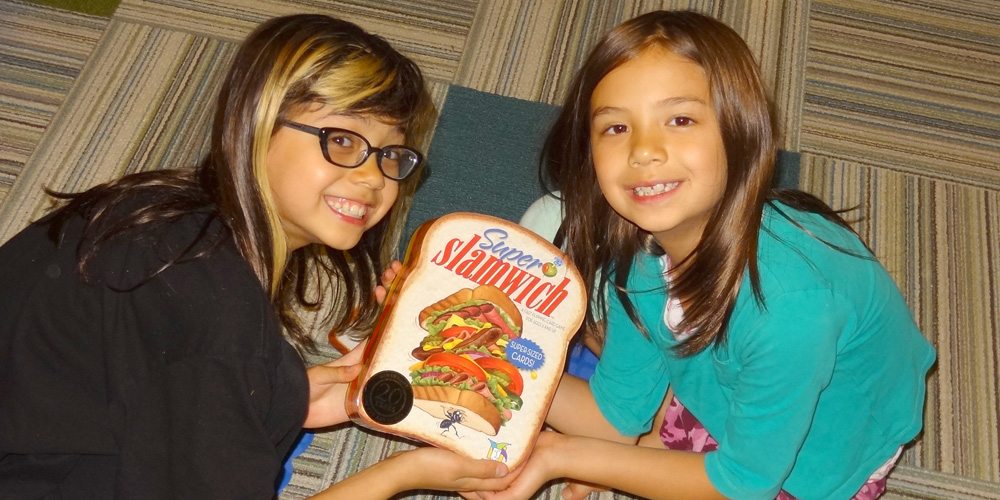
Look who turned 20 this year! Gamewright publishes a whole bunch of family-friendly games, with some easy enough for preschoolers and others challenging enough for your adult friends. To celebrate, they’ve got a special edition of the game that started it all, Slamwich, plus several new titles. Here’s a quick look at their latest titles.
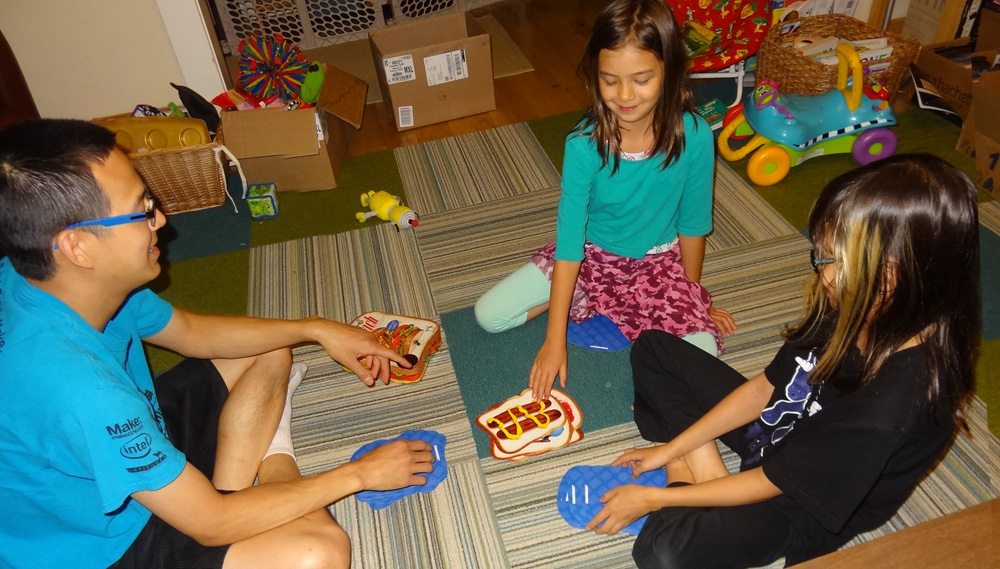
Super Slamwich: 2-6 players, ages 6 and up, 20 minutes
Slamwich was Gamewright’s very first game, and for the anniversary they’ve made an extra-large version with all-new artwork. Everyone gets a stack of cards, which look like slices of bread with stuff on them—tomatoes, peanut butter, hot dogs. Some of them have sandwich thieves or munchers, too. You take turns flipping cards onto a center pile, looking for an opportunity to slap the stack and claim the cards. Two identical cards in a row is a Double Decker, and one card between two identical cards is a Slamwich. You can also slap thieves (but you have to shout “Stop Thief!” while you do). Slap first, and you get the whole stack and add it to your pile. Run out of cards, and you’re out of the game.
The Munchers are a little trickier: each has a number in the corner, and the next player flips that many cards. If a Double Decker, Slamwich, or Thief comes up, anyone can slap in and claim them—otherwise, the player who played the Muncher takes the stack. (But Munchers can also get interrupted by other Munchers.)
It’s a fast-paced game that rewards attentive players. The extra-large version can be tricky for small hands to shuffle and deal, but my kids liked the novelty. For travel, though, you may want to stick with the original version.

Sushi Go!: 2-5 players, ages 8 and up, 15 minutes
My kids and I have also been enjoying Sushi Go!, which is a little more strategic than Slamwich and is really cute. Sushi Go! is a drafting game, which means you pick from a hand of cards and then pass that hand along to the next player. With so many games (like 7 Wonders) using drafting as part of the gameplay, it’s an important mechanic to learn, and Sushi Go! is a pretty nice way to teach it.
You play three rounds—for each round, everyone gets a certain number of cards (based on number of players). You pick a card to play face-down, then pass the rest of your hand. Once everyone has a card chosen, they’re turned face-up, and then you play a card from the new hand that was just passed to you. This continues until you’re only passed one card, which you play.
At the end of the round, players score points for the varieties of sushi they’ve collected: maki rolls score for the players who got the most, sashimi scores for sets of three, wasabi triples the value of nigiri, and dumplings are worth more if you have a big pile. Pudding is only scored at the end of the game, but whoever has the least pudding will lose points.
It’s a really clever game that has enough strategic decision-making to entice adults, but is easy enough that kids can grasp the mechanics. There’s a nice bit of risk-reward balancing: for instance, if you get 3 sashimi it’s worth 10 points, but if you only manage to get two of them, then you’ve wasted two turns that don’t score anything. Deciding what to take and what to pass to your neighbor makes for some delicious gameplay.

Qwixx: 2-5 players, ages 8 and up, 15 minutes
Qwixx reminds me a little of 20 Express, but with dice and slightly different choices. Your goal is to score the most points by crossing off numbers on your scorepad. The trick is, you can only cross things off from left to right—so once you’ve marked the red 5, you can no longer mark the red 2, 3, or 4. (Note that the blue and green tracks count down from 12.)
Each turn, the active player rolls all the dice, adds the two white dice together, and announces the result. Everyone may choose to cross off that number on one of their rows if they’d like to. Then the active player may choose one of the colored dice, add it to one of the white dice, and cross off that number in the corresponding color row (if available). If the active player doesn’t cross off any numbers, then she has to mark one of her penalty squares, which costs five points.

The last number in each row is special: you may only cross it out if you have at least five other numbers already crossed out in that row. When you do cross out the last number, you also mark off the “lock.” That color die is removed from the game, and none of the players may cross off numbers from that row for the rest of the game. The game ends when two colors have been locked or any player has all four of their penalty squares marked—total up your scores, and highest score wins.
I really like Qwixx. It’s a fast-playing game, but still requires a bit of thinking. Do you mark a number if it means skipping over two numbers? Three? If you skip too many numbers, you may end up having to take penalties if you don’t roll the right combinations on your turn. Overall, a fun dice game for kids and adults.

Pyramix: 2 to 4 players, ages 8 and up, 15 minutes
Pyramix is a game with a gimmick, but it’s a good gimmick. The special tray holds the dice to form a pyramid so that when you remove a die they slide down to fill in the space. The goal of the game is to get the most points—ankhs are worth 1 point, cranes 2 points, eyes 3 points (count the “legs” on the icons). You can only take a die if at least two faces are exposed, it’s not touching a cobra die face-to-face, and taking it won’t expose the tray.
Once there’s only a single layer of dice left in the tray, the cobra cubes are removed, along with any dice adjacent to them. Then, for each of the four colors, the player who collected the most ankhs of that color claims all of the remaining dice of that color in the tray.
I played this one with my family and it’s a lot of fun. Once you pull a die out, things slide and may reveal other dice. Some that were locked by cobra dice might become available after sliding down. You have to plan ahead. Also, you’ll want to watch how many ankhs other players are taking—by themselves they’re not worth as many points, but depending on what’s left in the tray, they could become very valuable at the end.
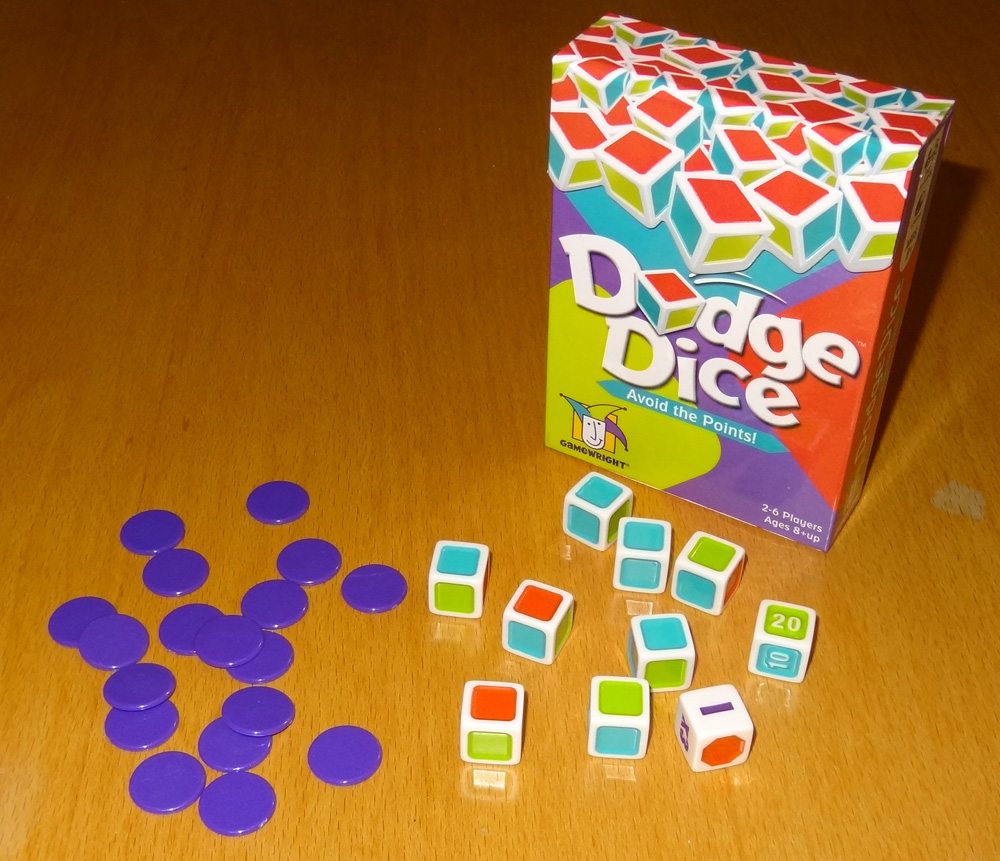
Dodge Dice: 2 to 6 players, ages 8 and up, 15 minutes (or less)
This one’s another quick dice game. Each player gets three skip chips to start. During each round, you’ll roll and pass the dice until somebody busts, at which point they score points—first player to 100 points loses, and the player with the lowest score wins.
The points die is only rolled at the beginning of each round, and indicates the number of points at stake. Any of the dodge dice that match the points die are set aside, and the rest of the dodge dice and the action die are passed to the next player. The action die includes things like “stop,” which means the round is over and the active player scores the points die; the purple circle lets you take another skip chip from the supply; various other icons will make you score double or triple the points die value, subtract the points die from your score, or even pass the points to another player—but only if you bust that turn.
If all of the remaining dodge dice match the color of the points die, then you’ve busted, and you score the points die (with modifications based on the action die). You may always pay one skip chip before you roll to pass the dice without rolling, or pay two chips to ignore the dice after your roll and pass them to the next player.
It’s a quick game that teaches a little bit of probability (the less-common color is worth the most points) but the action die might add too much luck into the mix. There is a press-your-luck element, but only if you have chips remaining and can actually choose whether or not to roll. If you have no chips, then your turn is completely luck-based. I prefer Qwixx to this one, but Dodge Dice may be good for a group looking for something more casual.
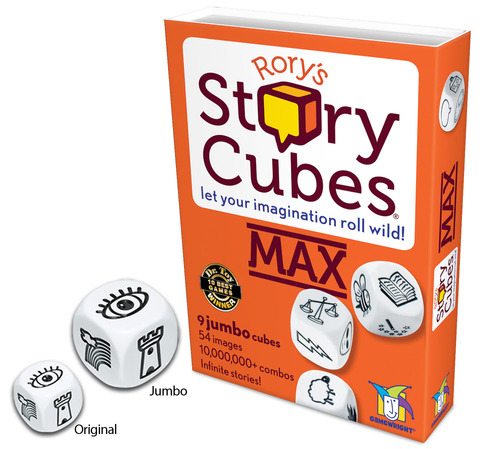
Rory’s Story Cubes MAX: 1 or more players, ages 8 and up, 15 minutes
Rory’s Story Cubes have been around for a while (and come in different flavors), but now you can get the enormous version—either for those who have low vision or dexterity, or because it’s fun to roll huge dice. Jenny Williams wrote more about them last week, so you can check out her review here.
Happy Birthday, Gamewright! Thanks for twenty years of great games, and best wishes for the next twenty as well!
Disclosure: Gamewright provided samples of these games for review.

